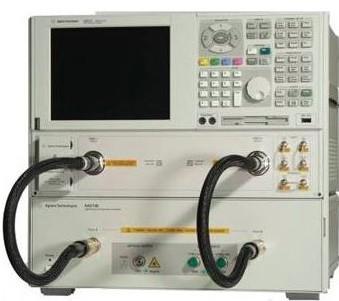
|
|
The Agilent N4373B Lightwave Component Analyzer (LCA) tests the most advanced 40 Gb/s electro-optical components, with up to 67 GHz modulation bandwidth. It achieves fast measurements by including an E8361A Performance Network Analyzer. In the N4373B, all optical and electrical components are carefully selected and matched to each other, to minimize noise and ripple in the measurement traces. Together with the temperature stabilization of the core components, this improves the repeatability and the accuracy of the overall system. It has the following measurement capabilities:
3dB cut-off frequency (S21),
Responsivity (S21),
Electrical reflection (S11 or S22),
Group Delay vs. frequency,
Insertion Loss (IL),
Transmission bandwidth (optical),
Transmission bandwidth (electro-optical),
all electrical S-parameter measurements.
Specifications.
Optical test set.
Operation frequency range: 10 MHz to 67 GHz (N5227A).
LCA optical input.
Operating input wavelength range: 1280 nm to 1625 nm.
Maximum linear average input power: +5 dBm (Input 1), +15 dBm (Input 2).
Maximum safe average input power: +7 dBm (Input 1), +17 dBm (Input 2).
Optical return loss (typical): > 27 dBo.
Average power measurement range: -20 dBm to +5 dBm (optical input 1), -10 dBm to +15 dBm (optical input 2).
Average power measurement uncertainty (typical): ±0.5 dBo.
LCA optical output.
Optical modulation index (OMI): > 5 % typ. at 1 GHz modulation frequency and -8 dBm RF power.
Output wavelength: 1550 ± 20 nm.
Average output power range: −1 dBm to +5.
Average output power uncertainty (typical): ± 0.5 dBo.
Average output power stability, 15 minutes (typical): ± 0.5 dBo.
Options.
-301; 67 GHz LCA based on E8361A-014, -010 (time domain) PNA and 1550 nm optical test set-102; 1310 nm and 1550 nm source optical test set.
-399; 67 GHz, 1550 nm optical test set with integration of - E8361A-014 customer supplied PNA, - E8361A-UNL customer supplied PNA.
-021; Straight FC/PC SM.
-022; Angled FC/APC SM.
|